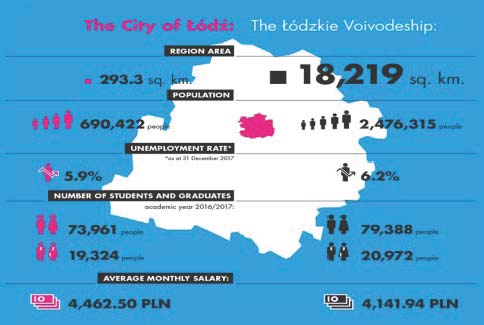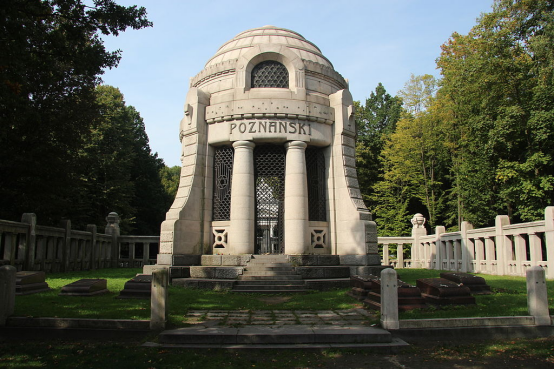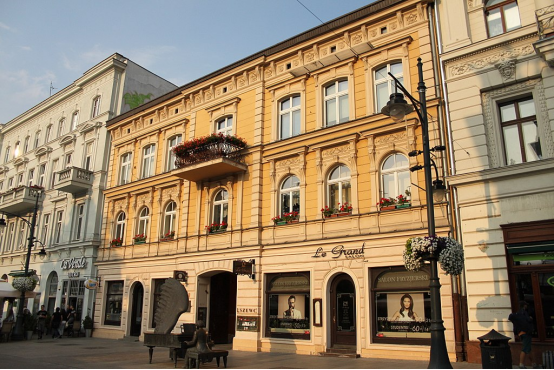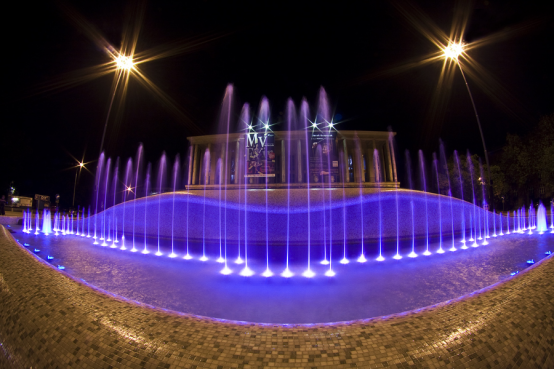Łódź 作者: 来源: 发布时间:2021-05-19
Ⅰ. Population and Area
Population (31 December 2019)
• City 679,941 Decrease (3rd)
Area
• City 293.25 km2 (113.22 sq mi)
https://uml.lodz.pl/
Ⅱ.Natural Geography
Łódź, city, capital of Łódzkie województwo (province), central Poland. It lies on the northwestern edge of the Łódź Highlands, on the watershed of the Vistula and Oder rivers, 81 miles (130 km) southwest of Warsaw.
Transport
Łódź is situated near the geographical centre of Poland, only a short distance away from the motorway junction in Stryków where the two main north-south (A1) and east-west (A2) Polish transport corridors meet, which positions the city on two of the ten major trans-European routes: from Gdańsk to Žilina and Brno and from Berlin to Moscow via Warsaw. It is also part of the New Silk Road, a regular cargo rail connection with the Chinese city of Chengdu operating since 2013. Łódź is served by the national motorway network, an international airport, and long-distance and regional railways. It is at the centre of a regional and commuter rail network operating from the city's various train stations. Bus and tram services are operated by a municipal public transport company. There are 130 km (81 mi) of bicycle routes throughout the city.
Major roads include:
A1: Gdańsk – Toruń – Łódź – Częstochowa – Cieszyn (national border)
A2: Świecko (national border) – Poznań – Łódź – Warszawa
S8: Wrocław – Sieradz – Łódź – Piotrków Trybunalski – Warszawa – Białystok
S14: Pabianice – Konstantynów Łódzki – Aleksandrów Łódzki – Zgierz
DK14: Łowicz – Stryków – Łódź – Zduńska Wola – Sieradz – Złoczew – Walichnowy
DK72: Konin – Turek – Poddębice – Łódź – Brzeziny – Rawa Mazowiecka
DK91: Gdańsk – Tczew – Toruń – Łódź – Piotrków Trybunalski – Radomsko – Częstochowa
Airport
Main article: Łódź Władysław Reymont Airport
The city has an international airport: Łódź Władysław Reymont Airport located 6 kilometres (4 miles) from the city centre. Flights connect the city with destinations in Europe including Turkey. In 2014 the airport handled 253,772 passengers. It is the 8th largest airport in Poland. [circular reference]
Public Transport
Piotrkowska Centrum tram station, also known as "The Unicorn Stable"
The Municipal Transport Company – Łódź (Miejskie Przedsiębiorstwo Komunikacyjne – Łódź), owned by the Łódź City Government, is responsible for operating 58 bus routes and 19 tram lines.
Rail
Łódź has a number of long distance and local railway stations. There are two main stations in the city, but with no direct rail connection between them—a legacy of 19th-century railway network planning. Originally constructed in 1866, the centrally-located Łódź Fabryczna was a terminus station for a branch line of the Warsaw-Vienna railway, whereas Łódź Kaliska was built more than thirty years later on the central section of the Warsaw-Kalisz railway. For this reason most intercity train traffic goes to this day through Łódź Kaliska station, despite its relative distance from the city centre, and Łódź Fabryczna serves mainly as a terminal station for trains to Warsaw. The situation will be remedied in 2021 after the construction of a tunnel connecting the two, which is likely to make Łódź Poland's main railway hub. The tunnel will additionally serve Łódź Commuter Railway, providing a rapid transit system for the city, dubbed the Łódź Metro by the media and local authorities. Two new stations are to be constructed on the underground line, one serving the needs of the Manufaktura complex and the other located in the area of Piotrkowska Street.
In December 2016, a few years after the demolition of the old building of Łódź Fabryczna station, a new underground station was opened. It is considered to be the largest and most modern of all train stations in Poland and is designed to handle increased traffic after the construction of the tunnel. It also serves as a multimodal transport hub, featuring an underground intercity bus station, and is integrated with a new transport interchange serving taxis and local trams and buses. The construction of the new Łódź Fabryczna station was part of a broader project of urban renewal known as Nowe Centrum Łodzi (New Centre of Łódź).
The third-largest train station in Łódź is Łódź Widzew. There are also many other stations and train stops in the city, many of which were upgraded as part of the Łódzka Kolej Aglomeracyjna commuter rail project. The rail service, founded as part of a major regional rail upgrade and owned by Łódź Voivodeship, operates on routes to Kutno, Sieradz, Skierniewice, Łowicz, and on selected days to Warsaw, with plans for further expansion after the construction of the tunnel.
Ⅲ.Economy
-ŁODŹ IN FIGURES

-Before 1990, the economy of Łódź was heavily reliant on the textile industry, which had developed in the city in the nineteenth century owing to the abundance of rivers used to power the industry's fulling mills, bleaching plants and other machinery. Because of the growth in this industry, the city has sometimes been called the "Polish Manchester" and the "lingerie capital of Poland". As a result, Łódź grew from a population of 13,000 in 1840 to over 500,000 in 1913. By the time right before World War I Łódź had become one of the most densely populated industrial cities in the world, with 13,280 inhabitants per km2, and also one of the most polluted. The textile industry declined dramatically in 1990 and 1991, and no major textile company survives in Łódź today. However, countless small companies still provide a significant output of textiles, mostly for export to Russia and other countries of the former Soviet Union. Łódź is no longer a significant industrial centre, but it has become a major hub for the business services sector in Poland owing to the availability of highly-skilled workers and active cooperation between local universities and the business sector.
-Izrael Poznański Palace
-The city benefits from its central location in Poland. A number of firms have located their logistics centres in the vicinity. Two motorways, A1 spanning from the north to the south of Poland, and A2 going from the east to the west, intersect northeast of the city. As of 2012, the A2 is complete to Warsaw and the northern section of A1 is largely completed. With these connections, the advantages of the city's central location should increase even further. Work has also begun on upgrading the railway connection with Warsaw, which reduced the 2-hour travel time to make the 137 km (85 mi) journey 1.5 hours in 2009. As of 2018, travel time from Łódź to Warsaw is around 1.2 hours with the modern Pesa SA Dart trains.
-Recent years have seen many foreign companies opening and establishing their offices in Łódź. The Indian IT company Infosys has one of its centres in the city. In January 2009 Dell announced that it will shift production from its plant in Limerick, Ireland to its plant in Łódź, largely because the labour costs in Poland are a fraction of those in Ireland. The city's investor friendly policies have attracted 980 foreign investors by January 2009. Foreign investment was one of the factors which decreased the unemployment rate in Łódź to 6.5 percent in December 2008, from 20 percent four years earlier
Ⅳ.Industrial Characteristics
-KEY SECTORS
-The development of the city is based on the Regional Development Strategy which aims at supporting innovation and enhancing cooperation and partnership between regional authorities and investors. The key sectors for the Łódzkie region are mainly involved in the modern textile and fashion industries, as well as advanced construction materials, IT, and telecommunications.
-Key Projects
-1. The City of Adventures is being created near Łódź
-A new amusement park Mandoria is planned to be opened in summer 2020. It is being built on 50 ha in Rzgów near Łódź.
-The City of Adventures is being created near Łódź - Urząd Miasta Łodzi https://uml.lodz.pl/en/aktualnosci/news/the-city-of-adventures-is-being-created-near-lodz-id30726/2019/10/4/
-2. Łódź Kaliska railway station will be rebuilt
-PKP Polskie Linie Kolejowe S.A. will thoroughly modernise the Łódź Kaliska train station: they will rebuild 5 plat-forms and build new passageways under the rails as well as footbridges. There will be new lighting on the platforms, sheds and benches and a readable passenger information system will be installed. In order to make it easier for the disabled to move around the station, lifts and tactile paving will lead to the platforms. The transport connection within the station will also be changed – there will be a new underground passageway from the railway station to the bus station. Travellers will get to the platforms 4 and 5 through a new passageway from the railway station building.
-Łódź Kaliska railway station will be rebuilt - Urząd Miasta Łodzi https://uml.lodz.pl/en/aktualnosci/news/lodz-kaliska-railway-station-will-be-rebuilt-id30009/2019/8/29/
Ⅴ.Attrations and Cityscape

Izrael Poznański's tomb at the New Jewish Cemetery in Łódź is one of the largest of its kind in the world

Sculpture of Artur Rubinstein on Piotrkowska Street in Łódź, where Rubinstein was born and raised

Fountain on Dąbrowski Square
The most notable and recognizable landmark of the city is Piotrkowska Street, which remains the high-street and main tourist attraction in the city, runs north to south for a little over five kilometres (3.1 miles). This makes it one of the longest commercial streets in the world. Most of the building façades, many of which date back to the 19th century, have been renovated. It is the site of most restaurants, bars and cafes in Łódź's city centre.
Łódź is a city of contrasts which intrigues almost at every step. It is full of factories and, at the same time, it is very green; eclectic but also avant-garde. Lodz dazzles with the lavishness of factory owners’ palaces and astonishes with artistic installations.
Although the history of the city spans over six hundred years, the dynamic development of Lodz came a little less than 200 ago. From a small town it was in the beginning of the 19th century, it quickly became the “promised land” giving dozens of thousands of families hope for a better tomorrow. Around the city, you can find numerous traces of the multicultural working class melting pot. Lodz was such a pot up to World War II. After the war, having become the cinematic capital of Poland, it opened another important chapter of its history. In 2017 Łódź was inducted into the UNESCO Creative Cities Network and named UNESCO City of Film.
Today it is a creative city, a city of festivals, a city which is being discovered all over again. It is located in the very heart of Poland, at the crossing of two main highways – you could say that all the roads lead to Lodz.
Ⅵ.History and Culture
Łódź is the third-largest city in Poland and a former industrial centre. Located in the central part of the country, it has a population of 679,941 (2019). It is the capital of Łódź Voivodeship, and is located approximately 120 kilometres (75 mi) south-west of Warsaw. The city's coat of arms is an example of canting, as it depicts a boat (łódź in Polish), which alludes to the city's name.
Łódź was once a small settlement that first appeared in 14th-century records. Despite being granted town rights in 1423, it remained the private property of the Kuyavian bishops and clergy until the late 18th century. The Second Industrial Revolution brought rapid growth in textile manufacturing and in population due to the inflow of migrants, notably Germans and Jews. Ever since the industrialization of the area, the city has struggled with multinationalism and social inequalities, which were documented in the novel The Promised Land by Nobel Prize-winning author Władysław Reymont. The contrasts greatly reflected on the architecture of the city, where luxurious mansions coexisted with redbrick factories and dilapidated tenement houses.
The industrial development and demographic surge made Łódź one of the largest cities in Poland. Under the German occupation during World War II, Łódź was briefly renamed to Litzmannstadt in honour of Karl Litzmann. The city's large Jewish population was forced into a walled zone known as the Łódź Ghetto, from which they were sent to German concentration and extermination camps. The city itself sustained insignificant damage during the war and became Poland's temporary seat of power in 1945.
Łódź experienced a sharp demographic and economic decline after 1989. It was only in the 2010s that the city began to experience revitalization of its neglected downtown area. Łódź is internationally known for its National Film School, a cradle for the most renowned Polish actors and directors, including Andrzej Wajda and Roman Polanski, and in 2017 was inducted into the UNESCO Creative Cities Network and named UNESCO City of Film.
Ⅶ.Other Information
The New Centre of Łódź (NCŁ) is a modern area at the heart of the city combining business, cultural, commercial, and transportation functions. With work underway, an area of nearly 100 ha in the city centre is subject to wide-spread revitalisation.
The NCŁ features the renovated building of the first power station in Łódź, EC1. The exceptional character of the place refers to the industrial past of the city. At present, EC1 performs cultural, artistic, and educational roles. At its heart is the largest Science and Technology Centre in Poland and a state-of-the-art planetarium. The EC1 complex is also the headquarters of institutions bringing together artists and film-makers – Łódź Film Commission and the Centre for Comics and Interactive Narration.
A major point in the New Centre of Łódź is the new underground station: Łódź Fabryczna, which became part of a multimodal transport network, combining railway, long-distance bus, and car transportation as well as the city’s public transport. The investment will also involve the reconstruction of the road system around the station, giving Łódź the opportunity to become a city with one of the best transport infrastructures in Poland.
Ⅷ.Contact Information
-Mayor Hanna Zdanowska (PO)
-CITY OF ŁÓDŹ OFFICE
-90-926 ŁÓDŹ, PIOTRKOWSKA 104
-CALL CENTER
-TEL.: + 48 (42) 638-44-44
-FAX: +48 (42) 272-60-01
-LCKM@UML.LODZ.PL
